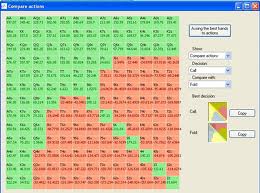Sage Poker System Calculator
The SAGE System in Heads Up Poker
Say you manage to get to the final table of a large field MTT and get into a heads up situation. It can be a pretty difficult situation to master especially when your stack is only 10BBs deep.
Using the Sales Analysis report in Sage 50 US Intelligence Reporting, we’ll demonstrate how you can use it to create a sales commission calculator. Note that this report may have a different name depending on your integration, but is typically is typically found in your Sales or Dashboard folder in the Report Manager. Conceptually, depreciation is the reduction in value of an asset over time, due to elements such as wear and tear. For instance, a widget-making machine is said to 'depreciate' when it produces less widgets one year compared to the year before it, or a car is said to 'depreciate' in value after a fender bender or the discovery of a faulty transmission.
But what if I told about a system that allowed you to play HU in a mathematically un-exploitable way? Well, introducing…the SAGE system!
(SAGE stands for Sit and Go End Game System).


The SAGE system was introduced in Lee Jones’ ‘Winning Low Limit Holdem’. It outlines how to play HU poker with less than 10BBs in a mathematically un-exploitable way. It uses power rankings on the cards that you’re dealt, letting you know when to push/shove.
Sage Poker System Calculator Free
First, let’s look over the conditions for when the SAGE System can be used:
- Heads Up at the end of a No-Limit Holdem MTT or SNG
- One prize
- Average stack-size is less than 10BBs
- The SB shoves all-in from the button. We have to make a decision whether to call or fold.
So, what is this SAGE System?
If there are any economists reading this than you should be familiar. The SAGE system is an “equilibrium strategy” for Game Systems, which means that if either opponent were to deviate from the SAGE strategy their expectation will go down (thus the others would go up). What this means for you is that no matter whether you’re playing the Dan Harrington or Chris Ferguson, it puts you in a level playing field effectively making it a coin-toss situation (subject to differences in chip stacks). Thus, it’s a great system for when you’re up against a much better opponent than you. It brings the odds more into your favour.
The SAGE system ranks each of the possible 169 starting hands in Texas Holdem according to their Power Rankings in Heads Up situations. AA is the best; 32 off suit is the worst etc…

Optimal Top Percentage and Cutoff Hands

| R | SB Top % | SB Cutoff Hand | BB Top % | BB Cutoff Hand | SB Edge |
| 1 | 89% | 6-2 suited | 100% | 3-2 offsuit | 0.010 |
| 2 | 79% | 6-4 suited | 89% | 6-2 suited | 0.051 |
| 3 | 74% | 9-5 offsuit | 70% | 7-5 suited | 0.061 |
| 4 | 71% | 10-4 offsuit | 60% | J-5 offsuit | 0.047 |
| 5 | 68% | 9-6 offsuit | 53% | 9-7 suited | 0.026 |
| 6 | 64% | 7-6 suited | 48% | Q-2 suited | 0.002 |
| 7 | 61% | 10-4 suited | 42% | Q-7 offsuit | -0.018 |
| 8 | 58% | J-2 suited | 39% | K-2 suited | -0.042 |
| 9 | 55% | 9-8 offsuit | 36% | 3-3 | -0.063 |
How to interpret the above table:
- The “R” column is the ratio of the short stack to the big blind, after the blinds have been paid. So if the short stack is 10,000 and the big blind is 2,000, R=5.
- The “SB Top%” is the percentage of hands that you should call all-in from the SB.
- The “BB Top%” is the same thing but for BB.
- The “SB Cutoff Hand” and “BB Cutoff Hand” is the worst hand in that criterion.
- “SB Edge” is the expected amount that SB can win, in terms of big blinds, if both players follow this system.
Simplified Version for Live Games
As interesting as these nerdy calculations are, it’s not the sort as practical in a live tournament setting. SAGE System simplifies the entire process into two steps, computing a Power Index (PI) and then using PI to know when to call.
How to Work Out PI
- Take the “power number” of each card in its rank (e.g. 10 = 10, J = 11, Q = 12, etc..).
- Take the power number for your highest card and double it.
- Add the power number to your lowest card.
- For Pocket Pairs, add 22.
- For suited connectors, add 2.
- The sum is the Power Index of your hand!.
Once you know the PI value of your hand, you can use the SAGE table below to know when to jam an opponent’s shove from SB or BB according to R. This strategy can be used for any HU situations such as SNGs, MTTs or especially satellite tournaments when there’s only one prize.
The SAGE Table
| R | Jam(SB) | Call(BB) |
| 1 | 17 | (any) |
| 2 | 21 | 17 |
| 3 | 22 | 24 |
| 4 | 23 | 26 |
| 5 | 24 | 28 |
| 6 | 25 | 29 |
| 7 | 26 | 30 |
Winning Poker System
Related articles:
Leave a Reply
- $400
- $2000
Sage Poker System Calculator Download
T&C apply to bonus offerings